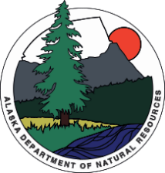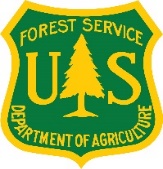|
FOR IMMEDIATE RELEASE March 29, 2019 Alaska Spruce Beetle Outbreak
Anchorage - March 29, 2019 - Southcentral Alaska continues to be heavily impacted by a spruce beetle outbreak that has occurred over the last few years. Warmer spring temperatures mean adult spruce beetles will soon be active again. Spruce beetles typically
emerge from their host trees when spring temperatures are around 60°F, which usually occurs in early to mid-May. In order to treat or prevent further infestations, landowners should examine their spruce trees now for signs of beetle attacks and seek information
on treatment options.
Spruce beetles are native to Alaskan forests and feed and breed in spruce trees. All native spruce species in Alaska and some ornamental spruce species can be hosts. Spruce beetle outbreaks are a natural occurrence that can’t be prevented but can be managed.
Spruce beetles prefer to attack recently damaged trees but will also attack and kill standing trees that are otherwise stressed or weakened. During outbreaks, seemingly healthy trees, particularly large diameter, slow-growing, mature trees, are attacked and
killed.
Landowners can look for the following signs of a spruce beetle attack on their spruce trees:
·
Reddish-brown boring dust at the base of a tree and in bark cracks
·
Reddish-brown pitch masses on the tree trunk indicating an attack site
·
Larvae tunneling beneath the bark creating a network that inhibits the trees ability to feed itself
If trees show signs of spruce beetle infestation, consider practices that will minimize the beetle’s ability to complete their life cycle and emerge to infest nearby trees, such as tree removal and subsequent debarking or chipping. Trees that have not been
attacked may be prioritized for protective treatments depending on the circumstances. Preventative treatments can be effective but may be time consuming and/or expensive and may not be practical for all situations. It is best to choose options that make sense
for the specific conditions that exist on a given property.
Infested spruce is often cut and used as firewood. If not sufficiently dry, adult beetles over-wintering under the bark could emerge during the warmer spring weather and seek a new host, often attacking live spruce trees in the vicinity. Inspect spruce firewood
for spruce beetle. Burn actively infested material before May, if possible, or process the material to prevent adult beetle emergence and potential damage to neighboring trees.
For information on mitigating spruce beetle, signs and symptoms of spruce beetle attacks, and upcoming public workshops, visit
www.alaskasprucebeetle.org.
Additional information is available at:
U.S. Forest Service, Forest Health Protection: https://www.fs.usda.gov/goto/alaskasprucebeetle
Alaska DNR Division of Forestry, Forest Health Program:
http://forestry.alaska.gov/insects
CONTACT: Jason Moan, DNR Division of Forestry (907) 269-8460,
jason.moan@xxxxxxxxxx
Tim Mowry, DNR Division of Forestry (907)356-5512
tim.mowry@xxxxxxxxxx
Alicia King, UDSA Forest Service, (907) 743-9444, aliciaking@xxxxxxxxx
Mona Spargo USDA Forest Service, (907) 743-9572, mspargo@xxxxxxxxx
|
Attachment:
Press Release3282018final.docx
Description: Press Release3282018final.docx





